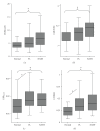Comparative evaluation of whole body and hepatic insulin resistance using indices from oral glucose tolerance test in morbidly obese subjects with nonalcoholic Fatty liver disease
- PMID: 20798875
- PMCID: PMC2925212
- DOI: 10.1155/2010/741521
Comparative evaluation of whole body and hepatic insulin resistance using indices from oral glucose tolerance test in morbidly obese subjects with nonalcoholic Fatty liver disease
Abstract
Nonalcoholic Fatty Liver Disease (NAFLD) is the hepatic manifestation of metabolic syndrome and is a marker of Insulin Resistance (IR). Euglycemic-hyperinsulinemic clamp is the gold standard for measuring whole body IR (hepatic + peripheral IR). However, it is an invasive and expensive procedure. Homeostasis Model Assessment Index for Insulin Sensitivity (HOMA-IS), Quantitative Insulin Sensitivity Check Index (QUICKI) for hepatic IR and Insulin Sensitivity Index (ISI(0,120)), and Whole Body Insulin Sensitivity Index (WBISI) for whole body IR are the indices calculated after Oral Glucose Tolerance Test (OGTT). We used these indices as noninvasive methods of IR (inverse of insulin sensitivity) estimation and compared hepatic/peripheral components of whole body IR in NAFLD. Methods. 113 morbidly obese, nondiabetic subjects who underwent gastric bypass surgery and intraoperative liver biopsy were included in the study. OGTT was performed preoperatively and the indices were calculated. Subjects were divided into closely matched groups as normal, fatty liver (FL) and Non-Alcoholic Steatohepatitis (NASH) based on histology. Results. Whole body IR was significantly higher in both FL and NASH groups (NAFLD) as compared to Normal, while hepatic IR was higher only in NASH from Normal. Conclusions. FL is a manifestation of peripheral IR but not hepatic IR.
Figures

Similar articles
-
The value of different insulin resistance indices in assessment of non-alcoholic fatty liver disease in overweight/obese children.Diabetes Metab Syndr. 2015 Apr-Jun;9(2):114-9. doi: 10.1016/j.dsx.2013.10.008. Epub 2013 Nov 14. Diabetes Metab Syndr. 2015. PMID: 25470627
-
[Prevalence of nonalcoholic fatty liver disease and metabolic syndrome in obese children].Zhonghua Er Ke Za Zhi. 2009 Feb;47(2):114-8. Zhonghua Er Ke Za Zhi. 2009. PMID: 19573457 Chinese.
-
Prevalence of biopsy-proven non-alcoholic fatty liver disease in severely obese subjects without metabolic syndrome.Clin Obes. 2016 Apr;6(2):117-23. doi: 10.1111/cob.12132. Epub 2016 Feb 8. Clin Obes. 2016. PMID: 26856683
-
The Effect of Low Glycemic Index and Glycemic Load Diets on Hepatic Fat Mass, Insulin Resistance, and Blood Lipid Panels in Individuals with Nonalcoholic Fatty Liver Disease.Metab Syndr Relat Disord. 2019 Oct;17(8):389-396. doi: 10.1089/met.2019.0038. Epub 2019 Jul 15. Metab Syndr Relat Disord. 2019. PMID: 31305201 Review.
-
Non-alcoholic Fatty Liver Disease and Metabolic Syndrome-Position Paper of the Indian National Association for the Study of the Liver, Endocrine Society of India, Indian College of Cardiology and Indian Society of Gastroenterology.J Clin Exp Hepatol. 2015 Mar;5(1):51-68. doi: 10.1016/j.jceh.2015.02.006. Epub 2015 Mar 6. J Clin Exp Hepatol. 2015. PMID: 25941433 Free PMC article. Review.
Cited by
-
Is the adiponectin-AMPK-mitochondrial axis involved in progression of nonalcoholic fatty liver disease?Hepatology. 2014 Jul;60(1):22-5. doi: 10.1002/hep.27134. Epub 2014 May 6. Hepatology. 2014. PMID: 24644076 Free PMC article. No abstract available.
-
The Wide and Complex Field of NAFLD Biomarker Research: Trends.ISRN Hepatol. 2014 Apr 28;2014:846923. doi: 10.1155/2014/846923. eCollection 2014. ISRN Hepatol. 2014. PMID: 27335843 Free PMC article. Review.
-
Analysis of factors influencing glucose tolerance in Japanese patients with non-alcoholic fatty liver disease.Diabetol Metab Syndr. 2017 Sep 5;9:65. doi: 10.1186/s13098-017-0264-7. eCollection 2017. Diabetol Metab Syndr. 2017. PMID: 28878826 Free PMC article.
-
The usefulness of metabolic score for insulin resistance for the prediction of incident non-alcoholic fatty liver disease in Korean adults.Clin Mol Hepatol. 2022 Oct;28(4):814-826. doi: 10.3350/cmh.2022.0099. Epub 2022 Jun 9. Clin Mol Hepatol. 2022. PMID: 35680169 Free PMC article.
-
The ASSIST trial: Acute effects of manipulating strength exercise volume on insulin sensitivity in obese adults: A protocol for a randomized controlled, crossover, clinical trial.PLoS One. 2024 May 28;19(5):e0302480. doi: 10.1371/journal.pone.0302480. eCollection 2024. PLoS One. 2024. PMID: 38805474 Free PMC article.
References
-
- Marchesini G, Bugianesi E, Forlani G, et al. Nonalcoholic fatty liver, steatohepatitis, and the metabolic syndrome. Hepatology. 2003;37(4):917–923. - PubMed
-
- Brunt EM, Janney CG, Di Bisceglie AM, Neuschwander-Tetri BA, Bacon BR. Nonalcoholic steatohepatitis: a proposal for grading and staging the histological lesions. American Journal of Gastroenterology. 1999;94(9):2467–2474. - PubMed
-
- James OFW, Day CP. Non-alcoholic steatohepatitis (NASH): a disease of emerging identity and importance. Journal of Hepatology. 1998;29(3):495–501. - PubMed
-
- Marrero JA, Fontana RJ, Su GL, Conjeevaram HS, Emick DM, Lok AS. NAFLD may be a common underlying liver disease in patients with hepatocellular carcinoma in the United States. Hepatology. 2002;36(6):1349–1354. - PubMed
-
- Chitturi S, Abeygunasekera S, Farrell GC, et al. NASH and insulin resistance: insulin hypersecretion and specific association with the insulin resistance syndrome. Hepatology. 2002;35(2):373–379. - PubMed
LinkOut - more resources
Full Text Sources

